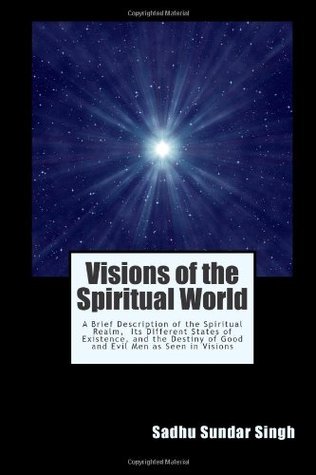Visions of the Spiritual World: A Brief Description of the Spiritual Realm, Its Different States of Existence, and the Destiny of Good and Evil Men as Seen in Visions
by Sadhu Sundar Singh
"In a distinctly Indian style, his wisdom challenges Western readers to taste the Gospel." -- Robert Ellsberg, author of All Saints "This little known book is an amazing gem. Its message is very consistent with The Book of Enoch, The Tibetan Book of the Dead and the New Testament. The visions experienced by Sadhu Sundar Singh are reminiscent of Christ's parable of Lazarus and the Rich Man as recorded in Luke.... In The Book of Enoch, Enoch is escorted by angels through the different levels of Heaven as he is educated on the mysteries of the spirit world. The Tibetan Book of the Dead discusses how the soul encounters wrathful dieties and peaceful dieties as it travels the bardos. Another interesting parallel can be found in The Dead Sea Scrolls because many of them discuss the Sons of Light and the Sons of Darkness. This is the exact same term used in Sadhu's book. I hope you find this book as inspiring as I did." -The Reluctant Messenger LIFE DEATH MAN CAN NEVER BE DESTROYED WHAT HAPPENS AT DEATH? THE WORLD OF SPIRITS SONS OF LIGHT SONS OF DARKNESS DEATH OF A CHILD DEATH OF A PHILOSOPHER UNSEEN HELP THE CORRECTION OF ERROR THE MANIFESTATION OF CHRIST A LABORER AND A DOUBTER THE JUDGMENT OF SINNERS A GOOD MAN AND A THIEF SECRET SINS WASTED OPPORTUNITIES A WICKED MAN PERMITTED TO ENTER HEAVEN THE SPIRIT OF A MURDERER AND THE SPIRIT OF THE MAN MURDERED THE SPIRIT OF AN ADULTERER THE SOUL OF A ROBBER THE STATE OF THE RIGHTEOUS AND THEIR GLORIOUS END THE DEATH OF A RIGHTEOUS MAN COMFORTING HIS DEAR ONES THE MANSIONS OF HEAVEN A PROUD MINISTER AND A HUMBLE WORKMAN HEAVENLY LIFE THE AIM AND PURPOSE OF CREATION NAMES IN HEAVEN SEEING GOD DISTANCE IN HEAVEN THE WITHERED FIG TREE IS MAN A FREE AGENT? THE MANIFESTATION OF GOD'S LOVE
BUY NOW
Paperback, 66 pages
Published January 6th 2014 by Createspace
© 2025 Bibleportal.com 版权所有.

Sadhu Sundar Singh (1889 - 1929)
Was an Indian Christian missionary. He is believed to have died in the foothills of the Himalayas in 1929. Sundar felt that his religious pursuits in Sikhism and the questioning of Christian and Hindu priests left him without ultimate meaning. Sundar resolved to kill himself by throwing himself upon a railroad track. He asked that whosoever is the 'True God' would appear before him, or else he would kill himself; that very night he had a vision of Jesus who opened Sundar's soul to the truth.In October 1906, he set out on his journey as a new Christian, wearing a turban and the yellow robe of a Hindu sadhu, an ascetic devoted to spiritual practice. Singh viewed himself as a sadhu, albeit one within Christianity rather than Hinduism, because he realised Christianity could not penetrate India unless it was in an Indian way. "I am not worthy to follow in the steps of my Lord," he said, "but, like Him, I want no home, no possessions. Like Him I will belong to the road, sharing the suffering of my people, eating with those who will give me shelter, and telling all men of the love of God."
Sadhu Sundar Singh was an Indian Christian missionary. He is believed to have died in the foothills of the Himalayas in 1929.
Searching since boyhood for the way to God, Sundar Singh found truth in Jesus Christ. On his sixteenth birthday, he was publicly baptised as a Christian in the parish church in Simla, a town high in the Himalayan foothills. For some time previously he had been staying at the Christian Leprosy Home at Sabathu, not far from Simla, serving the leprosy patients there. It was to remain one of his most beloved bases and he returned there after his baptism.
At sixteen, the former Sikh became a Christian Sadhu, or holy man, and at great risk devoted his life to Christ. With bare feet and few possessions, Sundar crossed the precarious Himalayas between India and Tibet many times, sharing the gospel with Hindus, Buddhists, Sikhs. As he traveled, Sundar constantly read the Bible, prayed, and meditated, confident that God was always with him, even in the face of death. Preaching in India, Europe, and as far away as America, this Indian saint impacted thousands with his quiet yet bold words and actions.
... Show more